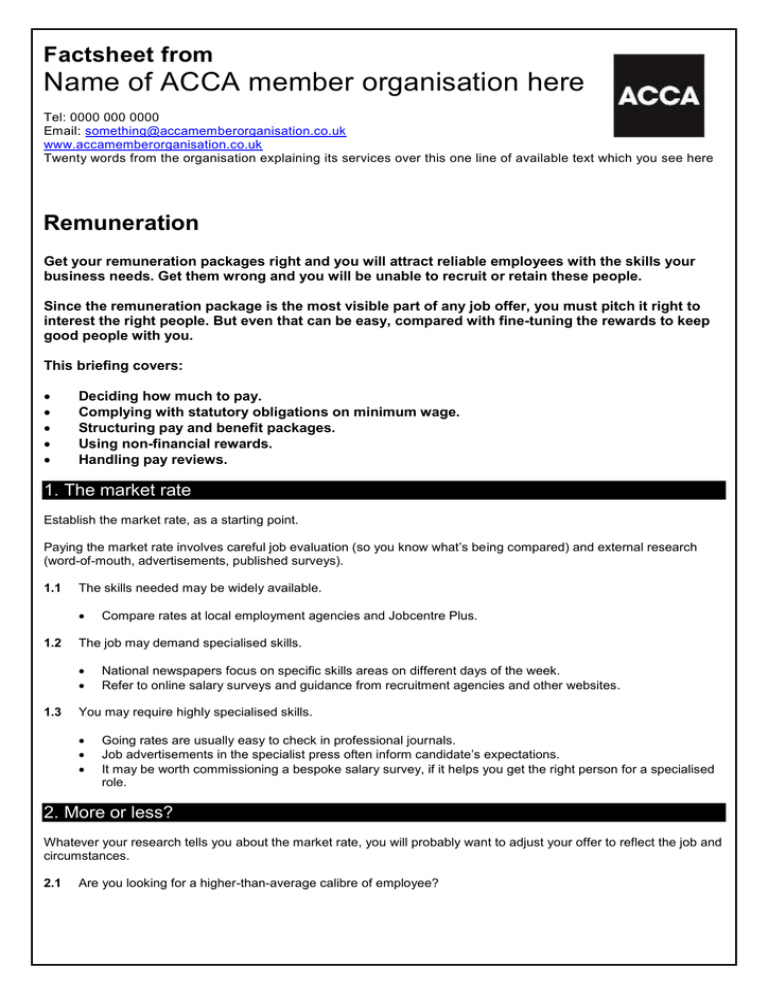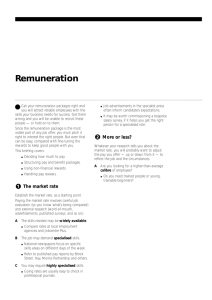
Factsheet from
Name of ACCA member organisation here
Tel: 0000 000 0000
Email: something@accamemberorganisation.co.uk
www.accamemberorganisation.co.uk
Twenty words from the organisation explaining its services over this one line of available text which you see here
Remuneration
Get your remuneration packages right and you will attract reliable employees with the skills your
business needs. Get them wrong and you will be unable to recruit or retain these people.
Since the remuneration package is the most visible part of any job offer, you must pitch it right to
interest the right people. But even that can be easy, compared with fine-tuning the rewards to keep
good people with you.
This briefing covers:
Deciding how much to pay.
Complying with statutory obligations on minimum wage.
Structuring pay and benefit packages.
Using non-financial rewards.
Handling pay reviews.
1. The market rate
Establish the market rate, as a starting point.
Paying the market rate involves careful job evaluation (so you know what’s being compared) and external research
(word-of-mouth, advertisements, published surveys).
1.1
The skills needed may be widely available.
1.2
The job may demand specialised skills.
1.3
Compare rates at local employment agencies and Jobcentre Plus.
National newspapers focus on specific skills areas on different days of the week.
Refer to online salary surveys and guidance from recruitment agencies and other websites.
You may require highly specialised skills.
Going rates are usually easy to check in professional journals.
Job advertisements in the specialist press often inform candidate’s expectations.
It may be worth commissioning a bespoke salary survey, if it helps you get the right person for a specialised
role.
2. More or less?
Whatever your research tells you about the market rate, you will probably want to adjust your offer to reflect the job and
circumstances.
2.1
Are you looking for a higher-than-average calibre of employee?
2.2
What are the particular problems you face in recruiting the right people?
2.3
Do you need trained people or are you prepared to offer training?
Are there geographical factors (eg travel to central London, or a remote location)?
Are the skills you need wanted urgently or in especially short supply?
Must you offer relocation allowances to attract good people from outside the area?
3. Basic pay
The most basic level of pay is set by law, with the national minimum wage (NMW). The NWM is currently fixed at £6.50
an hour for employees aged 21 or over, £5.13 for those aged 18 to 20 and £3.79 for workers aged 16 and 17.
Apprentices under the age of 19 or in the first year of their apprenticeship are entitled to a minimum hourly rate of
£2.73. Above that, you can decide what and how you pay your employees.
3.1
Will you pay by time or performance? There are several possible approaches.
The choice between wages and salaries is often a matter of tradition or expectations.
Weekly wages suit companies with a fixed working day, short working hours or irregular patterns of work.
3.2
Hourly pay may lead to high overtime costs if demand is irregular.
Annual hours contracts can offer flexibility for both you and your employees, while avoiding premium
payments for overtime.
Piece rates link pay directly to productivity.
Commission can range from the icing on the cake to the main element in the pay packet.
Your pay structure may be simple, but there should be some logic to it. It should be clear and fair.
The aim is to create a situation where employees can feel their pay is reasonable, compared with each other.
Part-timers and full-timers should be able to see how their pay is related.
You must meet your legal obligations (eg to give equal pay for work of equal value). Do not discriminate.
Record all decisions and make sure they are supported by a robust process.
Consider undertaking an equal pay review to identify any problematic areas and potential corrective
measures.
3.3
Decide what part overtime is going to play — and how you are going to value it.
3.4
Be aware of tax and National Insurance (NI) thresholds. Do not pay people amounts that will put them just above
a threshold.
3.5
It may be possible to use tax-efficient incentives, rather than raising pay (see 5).
Paying out cash as share dividends, rather than income, is still a tax-efficient way of remunerating shareholders
— usually directors, investors and senior employees.
If you and your partner are employed in the same business, make sure you have good evidence of what
each does. HM Revenue & Customs (HMRC) has targeted spouses receiving a disproportionate share of
dividends.
Dividends attract income tax, but no NI.
4. Bonuses and commission
Bonuses and commission payments need to be seen by employees as extras, or there will be no incentive effect.
4.1
Incentives work, if the targets are right.
2
4.2
Incentive pay is only effective when it relates to specific achievements.
It needs to be closely matched to the business and to the people involved.
Incentives based on competition backfire if the same people always win.
To get the desired results, you need to decide whose performance an incentive scheme should be based on.
Incentives may be linked to performance at the company, team or individual level.
The right linkage will depend on factors such as how much one person or group’s success depends on the efforts of
others.
4.3
Research shows many performance-related pay schemes give disappointing results, though this may often
be due to poor targeting and unrealistic expectations.
Profit-related pay is a type of performance-related pay that automatically reflects a whole company’s
achievements. Even without tax breaks, profit-related pay (paid to everyone at, say, 10% of salary) can be a
powerful, non-divisive incentive.
Performance bonuses need to be large enough to be significant to the individual.
You will usually need to make bonuses between 10 and 25% of salary to motivate employees effectively.
4.4
Other bonuses can be used to focus attention on areas that affect the success of your business (eg a weekly
productivity bonus or a 13th month’s pay to boost staff retention).
4.5
Commission is the usual basis of pay for sales operations.
But low-basic, high-commission pay structures may not be the best way to attract, motivate and retain
people.
5. Using shares and options
Share schemes and share option plans allow you to link long-term incentives to long-term goals. They give employees
a stake in the company’s growth.
5.1
Shares and options granted under HMRC-approved employee share schemes are free of income tax and NI, if
they are held for the specified period.
5.2
You may be able to offset the costs of setting up and funding such schemes against corporation tax.
Approved schemes include Share Incentive Plans (formerly All-Employee Share Ownership Plans),
Enterprise Management Incentive schemes and Seed Enterprise Investment Schemes.
Shares held by employees in the companies they work may count as business assets for capital gains tax (CGT)
purposes.
Employees who have adopted employee shareholder or employee owner status will be exempt from CGT on
gains on shares worth up to £50,000 in return for forgoing some employment rights.
5.3
Unapproved schemes bring fewer tax breaks, but can be set up on a larger scale.
5.4
One brake on the progress of share plans in smaller companies is often the original owners’ concern about
diluting their equity.
You also have to negotiate a market value of the shares with HMRC.
It is advisable to seek professional advice on the tax treatment of any share scheme you offer or are considering.
6. Benefits
3
NI is payable on most taxable benefits in kind. If there is tax on a benefit, the employer usually has to pay NI at 13.8%
(2014/15).
6.1
Pensions are usually the first benefit provided for employees.
All employers are being required to automatically enrol in and contribute towards a workplace pension for all
eligible employees who are not already in a workplace pension scheme (being phased in between October 2012
and February 2018).
Contributions are treated favourably, with no tax or NI to pay on HMRC-approved schemes.
6.2
Cars and car parking are still high on the list of benefits that employees find attractive.
6.3
Though the tax advantages of a company car have been reduced, most employees still accept a car if
offered.
A parking space at or near the place of work can be a valuable tax-free benefit.
There is no tax to pay on mobile phones provided by an employer (restricted to one phone per employee).
Additional phones provided to an employee or members of his or her family will be liable to tax.
If employees have part of their home phone bills reimbursed, including some private call costs, they will have
to pay tax. It may be better to provide mobiles.
6.4
Childcare vouchers up to £55 per week per employee can be provided on a tax and NI free basis.
6.5
Living accommodation can be tax free for those who have to live in a certain place to do the job (eg caretakers
and oil rig crews).
6.6
Elsewhere, it is taxed as a benefit. But even with the tax charge, potential recruits may find the offer of
accommodation attractive.
There are several benefits that cost little to provide, are valued highly by employees and get favourable tax
treatment.
Staff discounts (on your products) are not taxed and can be an attractive perk (eg in retailing, transport and
travel).
Personal loans of up to £10,000 are not taxable and do not attract NI. Offering season ticket loans or
interest-free loans to clear credit card debts can build loyalty.
Long-service awards do not attract tax, providing the employee has worked for the business for 20 years.
The value can be up to £50 for each year of service.
Annual parties (or similar celebrations) paid for by the employer are tax free, up to a cost of £150 a head.
Bicycles provided by an employer to employees are not liable to tax or NI.
Analyse the full costs and benefits of all the perks you offer.
7. Non-financial extras
Money is not the only thing people want from their jobs — and not the only motivator.
7.1
Use holidays creatively, as part of the employment package.
Agreeing to extra unpaid leave may provide a trade-off if you cannot afford full market rates for specialist
skills.
7.2
Flexitime working can be a powerful attraction for potential recruits.
7.3
Job content and fulfilment are what many people want most from their work.
Most employees want to be extended (‘stretched’), but not stressed.
4
7.4
Use appraisals to fine-tune the role and get the best out of the person.
The feeling of doing something worthwhile, for a worthwhile organisation, is a strong motivator for many
people.
Training is particularly attractive to young, ambitious employees.
Experience in a new role enhances a person’s CV and earning potential.
Training makes the person more valuable to you, but also to any other employer.
8. Pay reviews
Pay reviews need to be regular and should be kept separate from performance reviews.
Aim for a steady increase in real earnings, over the months and years, for employees whose performance is
satisfactory.
Build in a performance-related element for every employee, including juniors.
Ask people what their needs are.
A dissatisfied employee will not always be won over by a pay rise, even a large one.
Make a clear distinction between promotion and increases in pay for the job.
If there are workplace trade unions, involve them in pay structure reviews.
You must pay equal pay for work of equal value; and this applies to bonuses and commissions as well as basic
rates of pay.
Employment tribunals are required to order a pay audit if an employer is found to have breached equal pay
rules.
One for all
A.
Membership of healthcare schemes is attractive. It is treated as a taxable benefit in kind. The employee pays tax
on it, and the employer must declare it on Form P11D.
B.
Insurance cover helps employees guarantee their families some security.
C.
Employers have to pay NI too (see 6).
Life assurance and death-in-service benefits are normally linked to pension schemes and are not usually
liable to tax.
Premiums paid for critical illness cover and income protection insurance are not taxed. Instead, the money
paid out by such policies is taxed as income.
Benefits like this can be bought much more cheaply through group schemes than by individual employees paying
high premiums out of taxed income.
Group schemes offer acceptance, up to certain limits, without medical questions.
Experts’ quotes
“Recruiting people is relatively easy. The hard part is judging the whole remuneration package so that you are able to
keep the good people with the skills and experience the company needs.”
Lesley Stalker,
Robert James Partnership
5
“If you can’t afford to incentivise your key staff by paying them in cash bonuses, then using employee share schemes
— by awarding them shares or share options, subject to performance — may be your best response to potential staff
retention problems.”
Fred Hackworth,
Employee Share Ownership Centre
“Overwhelmingly, exit interviews show that most employees only join another company ‘for more money’ if they are
unhappy in their existing job in the first place.”
Bob Havard,
Havard Consulting
Expert contributors
Thanks to Richard Pettinger (University College London, 020 3108 1024); David Daly (Horwath Clark Whitehill
accountants, 020 7842 7100); Fred Hackworth (Employee Share Ownership Centre, 020 7436 9936); Lesley Stalker
(Robert James Partnership; 0870 225 5220).
Last reviewed 01.10.14
© Atom Content Marketing 2014. ISSN 1369-1996. All rights reserved. No part of this publication may be reproduced or transmitted without the
written permission of the publisher. This publication is for general guidance only. The publisher, expert contributors and distributor disclaim all liability
for any errors or omissions. Consult your local business support organisation or your professional adviser for help and advice.
6





